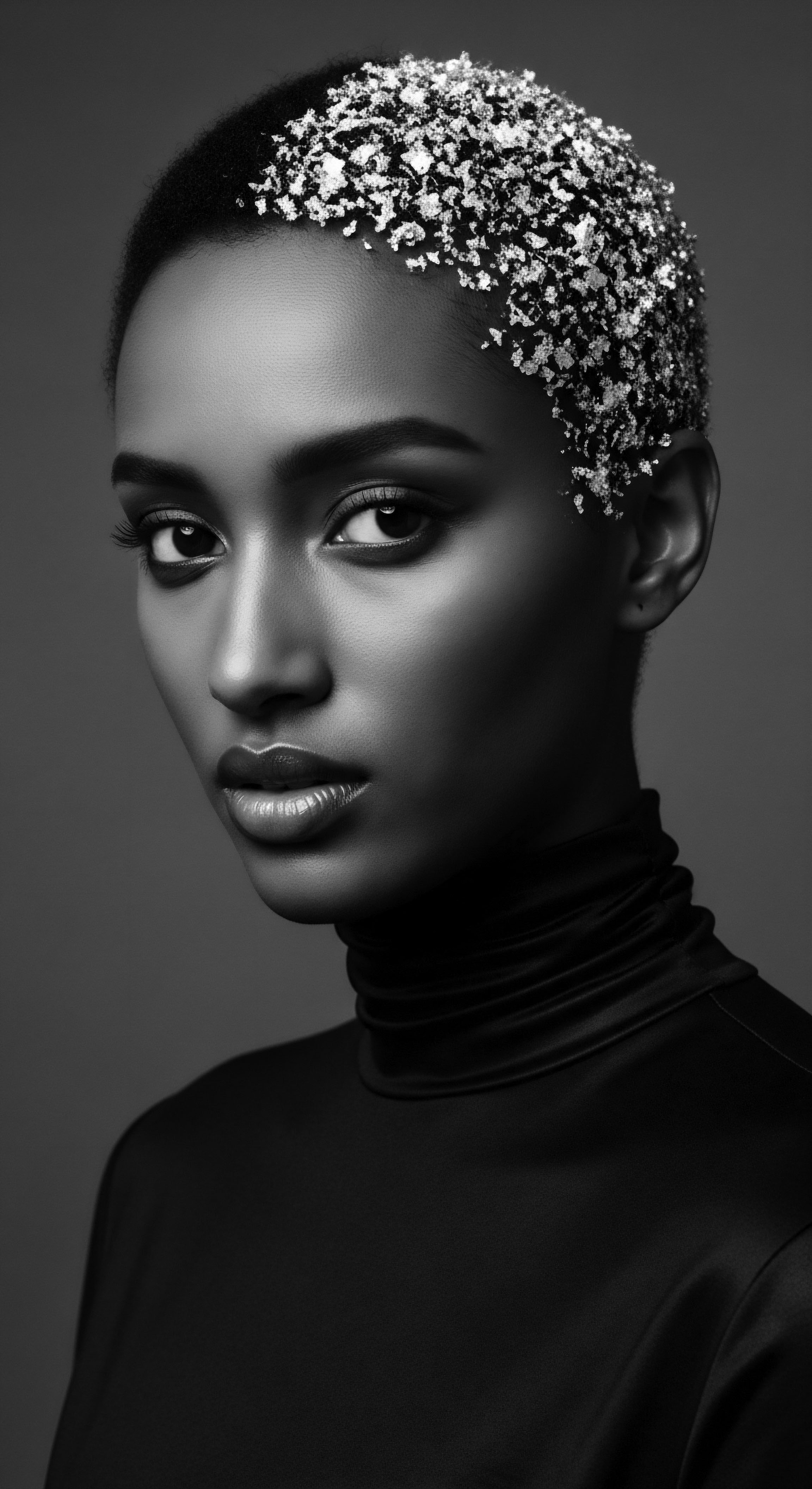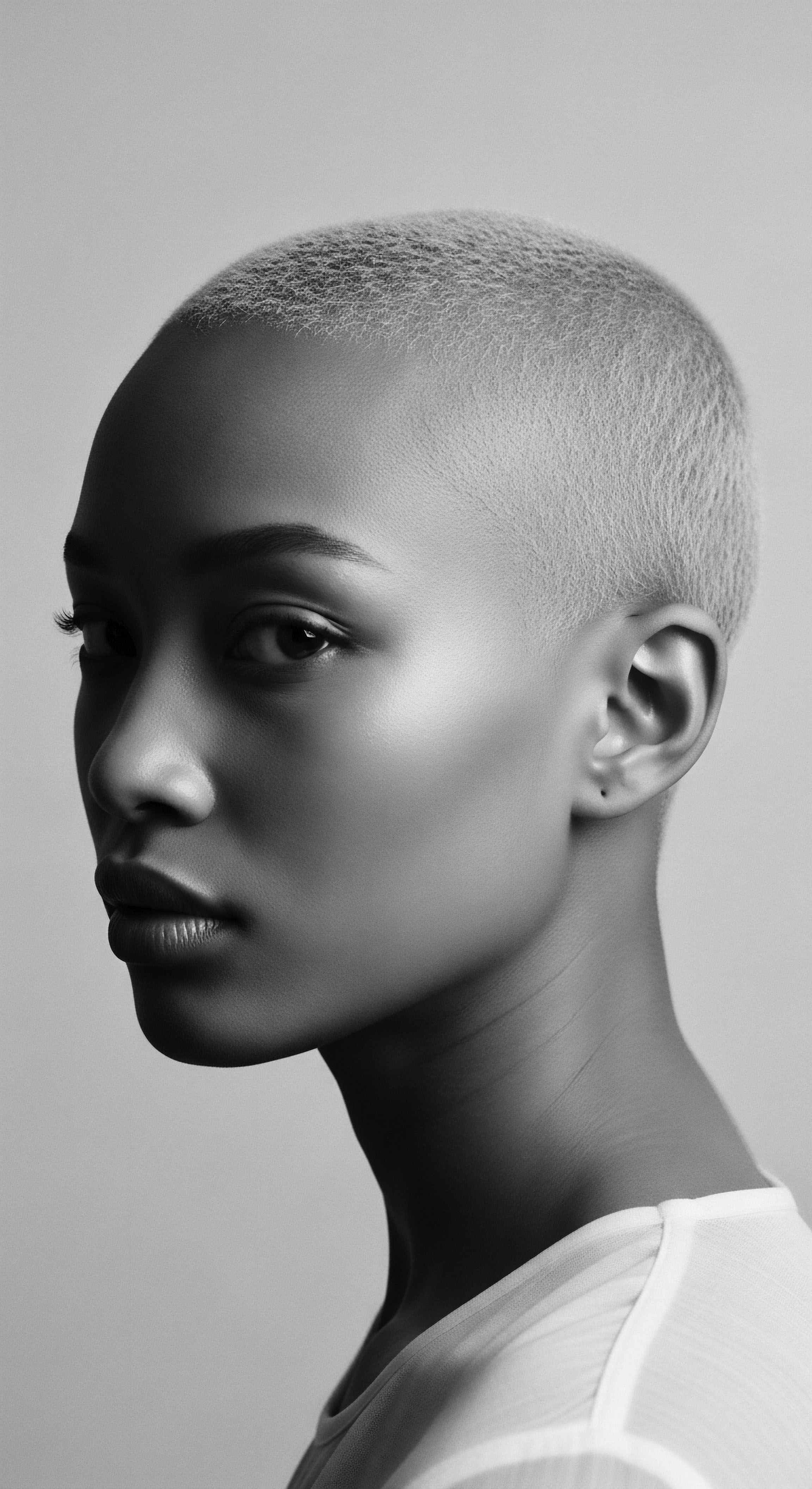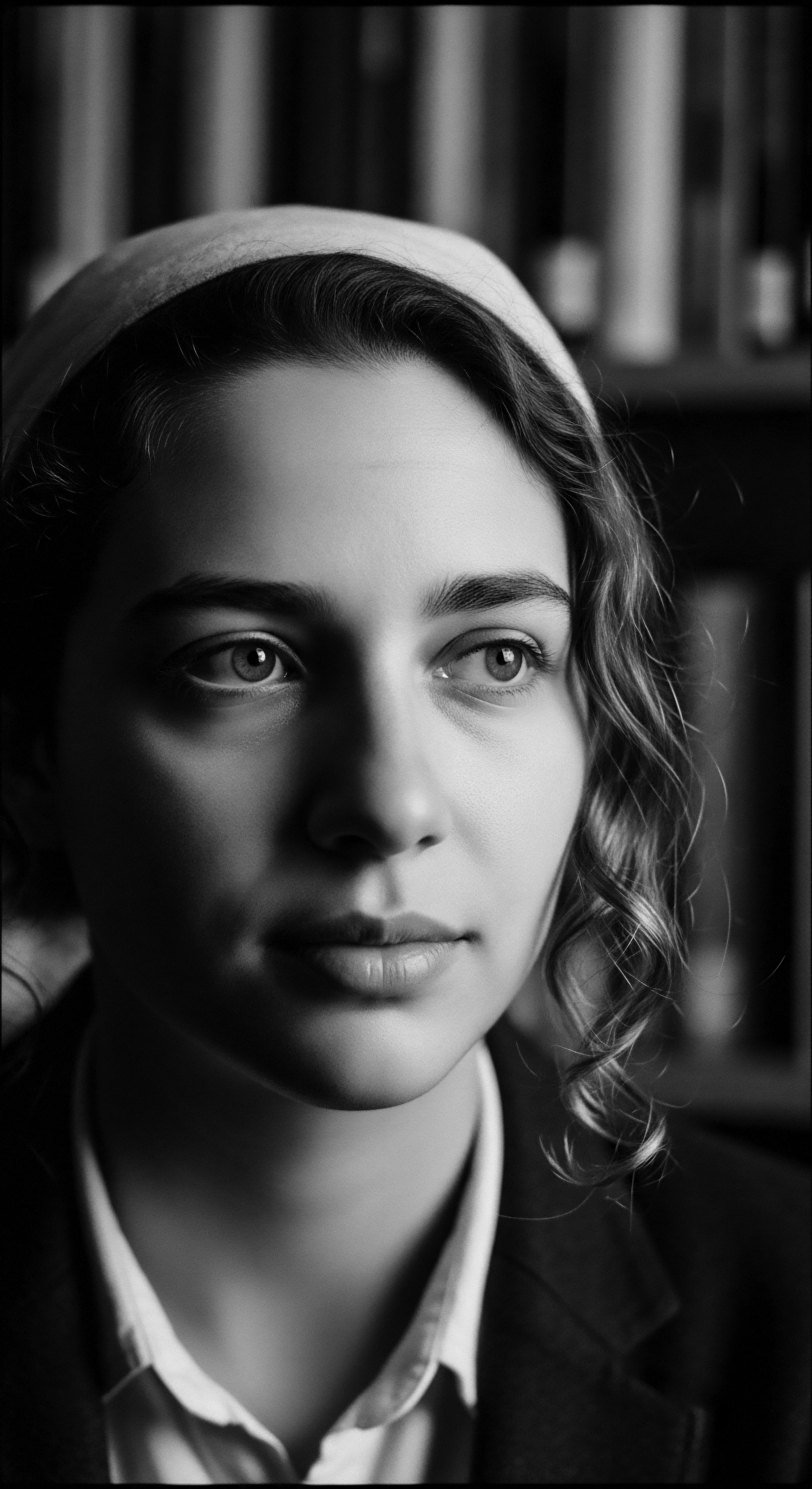
Roots
The strands that crown us, particularly those with the deep, captivating coil and spring of textured hair, carry whispers from time immemorial. They are not merely biological structures; they hold archives of identity, resilience, and belonging. When we speak of head coverings for textured hair, we speak of more than adornment or practicality. We speak of a continuum, a living lineage stretching back to the earliest human civilizations, a story written in cloth and knot, deeply connected to the very essence of Textured Hair Heritage .
Each fold, each vibrant hue, each carefully draped fabric, holds a memory, a cultural meaning that speaks volumes of ancestral wisdom and enduring spirit. It is a profound meditation on the enduring power of self-expression and preservation.

Ancestral Hair Anatomy and Physiology
The unique helical shape of textured hair, often elliptically shaped at the follicle, gives it strength and a distinct curl pattern. This structure, a marvel of natural engineering, has shaped styling practices and care traditions for centuries. Early communities understood, perhaps intuitively, the specific needs of these coils long before modern science articulated the concepts of porosity or elasticity.
Their practices, from specialized braiding to the application of plant-based oils, were ancestral scientific acts, designed to protect and honor this natural form. Head coverings, in this context, served as an extension of this deep understanding, safeguarding delicate strands from environmental elements and preserving intricate styles.
The hair’s ability to resist breakage and maintain moisture, given its structural peculiarities, was a continuous concern. Traditional societies, observing the natural world, drew parallels between the resilience of native fibers and the inherent strength of their hair. This intimate knowledge of hair’s biology, passed down through generations, shaped their approach to its upkeep and adornment.

Textured Hair Classification Systems
While modern systems classify textured hair by numbers and letters, often reflecting a Eurocentric lens that prioritizes straightness, ancestral communities had their own nuanced understandings. Their classifications were less about numerical categories and more about the lived experience of hair within a community ❉ its role in rites of passage, its connection to social standing, or its symbolic ties to the spirit world. For instance, the Adinkra symbols of Ghana, often seen on textiles and carvings, embody concepts like resilience, adaptability, and protection. These cultural symbols, representing abstract ideas, offer a way to understand the inherent meaning attributed to hair and its coverings, far beyond mere texture.
Head coverings for textured hair are living archives, whispering tales of identity, resilience, and belonging across generations.

The Essential Lexicon of Textured Hair
The language surrounding textured hair care is rich with terms born from centuries of practice. Beyond modern definitions, we encounter words like Gele (an elaborate Nigerian headwrap signaling status and celebration), Dhuku or Doek (southern African terms for head coverings often signifying respect or womanhood), and Tichel (a head covering in Jewish tradition). These terms are not mere labels; they are vessels carrying cultural weight, each word a doorway to a specific practice, a particular community, and a unique thread of heritage. Understanding them provides a deeper appreciation for the role of head coverings as part of a shared global dialogue around hair.

Hair Growth Cycles and Influencing Factors
Hair growth, a continuous, subtle cycle, was perceived through an ancestral lens often intertwined with life’s rhythms. Environmental factors, such as harsh sun, dust, and wind, were understood to influence hair’s vitality. Nutritional practices, rooted in local flora and fauna, also played a part in maintaining hair health.
Head coverings provided immediate, intuitive solutions for these challenges, offering protection and allowing for the undisturbed growth and preservation of elaborate styles. They acted as a shield, ensuring the continuation of healthy hair, which in many societies was tied to notions of beauty, spirituality, and social standing.

Ritual
The hands that style textured hair engage in a ritualistic dance, a dialogue between ancient practices and modern expressions. Head coverings are not simply accessories; they are central to this dance, reflecting a heritage of creativity, protection, and profound self-expression. They transform hair into a canvas, a statement, or a silent shield, deeply rooted in ancestral methods of care and adornment. These practices, honed over generations, reveal a nuanced understanding of textured hair’s capabilities and its symbolic power within various communities.

Protective Styling Heritage
The legacy of protective styling, deeply intertwined with the use of head coverings, dates back centuries across African and diasporic cultures. Styles like Cornrows, Braids, and Twists, often intricately woven, protected the hair from environmental stressors and reduced manipulation. Head wraps became a natural extension of these styles, offering an additional layer of preservation, especially during sleep or strenuous activity.
They helped maintain the integrity of these labor-intensive styles for longer periods, a practical necessity in societies where hair care was often a communal and time-consuming endeavor. The act of wrapping was a daily ritual, a quiet moment of care that echoed the collective wisdom of generations safeguarding their hair.
- Gele ❉ A West African headwrap, particularly prominent among Yoruba and Igbo women, signifying celebration, marital status, or social standing. Its complexity often reflects the wearer’s status.
- Doek/Dhuku ❉ Commonly used in Southern Africa, this head covering can serve practical purposes (like protecting hair from dust) and symbolic ones, indicating respect, cultural pride, or womanhood.
- Tignon ❉ Historically, in 18th-century Louisiana, free women of color were forced to wear head coverings, but they transformed these into elaborate, defiant fashion statements.

Natural Styling and Definition Techniques
The quest for natural hair definition, a hallmark of modern textured hair care, finds its roots in ancient practices. Head coverings, beyond protection, also played a role in achieving desired hair states. Certain wrapping techniques, combined with specific natural emollients or waters, could help set curls, minimize frizz, or compress hair into a particular shape.
This was a subtle art, relying on observation and inherited knowledge, a precursor to today’s focus on curl pattern enhancement. The material of the wrap, whether silk, cotton, or a specific local fabric, was chosen for its tactile properties and its interaction with the hair’s inherent characteristics.

Head Coverings and Historical Hair Extensions
The tradition of augmenting hair, through extensions or wigs, is not a modern invention; it spans centuries. Head coverings, in many historical contexts, were used to secure these additions, or to provide a foundation for elaborate hair designs that incorporated extra hair. In ancient Egypt, for instance, elaborate wigs were often worn, and head coverings might have been used to protect or complement them.
As African hair traditions traveled across continents, particularly during the transatlantic slave trade, the practice of creating intricate hairstyles, sometimes incorporating additional fibers, persisted. Head coverings often served as a means to maintain these complex styles, or to discreetly cover hair during times of forced labor.
Head coverings transform hair, acting as a historical bridge between ancestral protection and modern self-expression.

Heat Styling and Thermal Reconditioning
While modern heat styling involves sophisticated tools, the concept of using warmth to manipulate hair has ancestral roots, albeit through different means. Sun-drying after water-based treatments, or using gentle warmth from heated stones, might have been primitive forms of thermal setting. Head coverings, particularly those made of breathable materials, could aid in controlled drying, preventing excessive heat exposure while encouraging certain curl definitions. This historical understanding contrasts sharply with the often damaging modern approaches to thermal reconditioning, underscoring the ancestral reverence for hair’s natural state.
The careful balance between manipulation and preservation was a continuous thread in traditional hair care. Head coverings represented a gentle approach, prioritizing hair’s integrity rather than radical alteration.

The Complete Textured Hair Toolkit
The toolkit for textured hair, historically and presently, includes more than combs and brushes. It comprises a collection of natural ingredients, specialized hands, and, prominently, various head coverings. These coverings were chosen based on material, size, and cultural significance. The choice of a particular fabric—be it a richly dyed indigo cloth from West Africa or a soft, natural cotton from the Caribbean—was often dictated by practical needs, aesthetic values, and symbolic meaning.
| Traditional Purpose Protection from elements (sun, dust) |
| Modern Application (Heritage Lens) Shielding hair from pollution and UV rays, preserving moisture |
| Traditional Purpose Maintaining styled hair overnight |
| Modern Application (Heritage Lens) Minimizing frizz and breakage during sleep, preserving curl patterns |
| Traditional Purpose Signaling social status or marital standing |
| Modern Application (Heritage Lens) Expressing cultural identity, personal style, or communal belonging |
| Traditional Purpose Spiritual or religious observance |
| Modern Application (Heritage Lens) Continuance of faith practices and ancestral reverence |
| Traditional Purpose Concealing hair during forced labor/oppression |
| Modern Application (Heritage Lens) A symbol of resistance and reclamation of beauty |
| Traditional Purpose The enduring utility and symbolic power of head coverings speak to a continuous story of adaptation and defiance. |

Relay
The story of head coverings for textured hair is a continuous relay, a passing of ancestral knowledge and defiant spirit across generations. It transcends superficial trends, offering a deep understanding of self, community, and the profound resilience encoded within Black and mixed-race experiences. This relay carries the wisdom of elemental biology through living traditions, shaping identity and inspiring futures. We observe how the meanings attached to head coverings reflect a dynamic interplay of historical forces, cultural expression, and the ongoing journey towards self-acceptance.

Connecting Ancestral Wellness to Modern Regimens
The holistic approach to hair care, so prevalent in ancestral wellness philosophies, finds its modern echo in regimens emphasizing gentle treatment and natural ingredients. Head coverings were integral to this philosophy, serving as a protective embrace for hair undergoing treatments with natural oils, butters, and herbs. The wisdom of these practices suggests that true hair health extends beyond mere appearance, touching upon the mind and spirit. Our contemporary understanding of scalp microbiome or protein structures can, in a way, validate the long-standing effectiveness of these inherited practices, offering a bridge between scientific inquiry and ancient wisdom.
Head coverings, particularly those worn for extended periods, contributed to an optimal environment for hair nourishment. They helped to retain moisture from natural conditioners and kept botanical remedies undisturbed, allowing them to penetrate and soothe the scalp. This gentle, consistent care, often performed as a quiet ritual, formed the bedrock of ancestral hair wellness.

The Nighttime Sanctuary and Bonnet Wisdom
The tradition of protecting hair during sleep, particularly with head coverings, has a lineage as ancient as the act of slumber itself. The modern satin or silk bonnet, a ubiquitous item for those with textured hair, is a direct descendant of practices that recognized the vulnerability of hair against abrasive surfaces. Before mass-produced fabrics, communities utilized softer natural materials, often carefully prepared, to create coverings that minimized friction and preserved moisture.
This practice was not merely about maintaining a hairstyle; it was a ritual of preservation, a small act of self-care passed down through generations, safeguarding hair’s inherent integrity. The wisdom held within the seemingly simple bonnet speaks of centuries of understanding how to preserve delicate strands from tangling and drying.
This commitment to nighttime care highlights a deeper respect for the hair as a living extension of self. It signals a recognition that hair requires consistent, gentle tending to thrive. The choice of material for these sleep coverings—soft, smooth fabrics—reflects an intuitive grasp of how to reduce mechanical stress on the hair shaft, a principle now affirmed by trichology.

How Does Ancestral Resilience Inspire Contemporary Head Covering Practices?
The enduring cultural meanings linked to head coverings for textured hair are perhaps most powerfully illuminated by the historical defiance of the Tignon Laws in late 18th-century Louisiana. In 1786, Spanish colonial Governor Esteban Miró enacted an edict requiring free women of color in New Orleans to wear a tignon or headscarf when in public. This law was a direct attempt to control and diminish their perceived beauty, which often included elaborate hairstyles adorned with jewels and feathers, and to visually distinguish them from white women in a racially stratified society. Far from being subdued, these women, instead, transformed the mandated coverings into statements of exquisite style and overt rebellion.
They sourced the most luxurious fabrics, adorned their tignons with vibrant colors and intricate knots, and added their own precious embellishments, turning an instrument of oppression into a symbol of their enduring grace and unyielding spirit. This act of transforming a tool of subjugation into an expression of beauty and resistance is a profound example of how communities adapt and redefine narratives around head coverings. It is a testament to the fact that forced restriction can inadvertently become a catalyst for creative, cultural reclamation, a heritage of self-possession that continues to resonate.

Traditional Ingredients and Their Enduring Relevance
Many traditional head coverings were more than just fabric; they were often impregnated or used in conjunction with natural ingredients known for their conditioning or protective properties. Plant oils, herbal infusions, and even specific clays were applied to hair and scalp, then covered to allow for deep penetration and absorption. This practice parallels modern deep conditioning treatments, revealing how ancestral societies intuitively understood the benefits of prolonged contact between natural emollients and hair.
- Shea Butter ❉ Revered across West Africa, applied for moisture and protection, often before covering hair.
- Coconut Oil ❉ A staple in many tropical regions, used for conditioning and sealing the hair shaft, sometimes under light wraps.
- Aloe Vera ❉ Its soothing and hydrating properties were utilized for scalp health, often under loose head coverings to allow air circulation.

Resolving Hair Challenges with Heritage-Informed Solutions
Challenges such as dryness, breakage, or scalp irritation are not new. Ancestral methods often addressed these issues through a combination of topical applications and the strategic use of head coverings. For instance, tightly wrapped hair might have been a solution for minimizing damage during physical labor, while looser wraps could aid in soothing an irritated scalp by retaining moisture.
The cultural meaning of head coverings here shifts from mere fashion to practical, health-preserving solutions rooted in generations of trial and adaptation. This ancestral wisdom offers a valuable lens through which to approach contemporary hair problems, suggesting solutions that honor hair’s natural inclinations and communal practices.
The evolution of how head coverings are used to solve hair problems provides a compelling case study. From the essential role of the dhuku in protecting Zimbabwean women’s hair during daily chores in rural areas to the widespread use of satin scarves in urban settings to prevent friction breakage overnight, the underlying principle of preservation persists. These practices underscore a deep, practical knowledge of hair’s needs, passed down through the ages.

Holistic Influences on Hair Health
Ancestral wellness philosophies viewed hair as an extension of one’s overall well-being, deeply connected to spiritual, emotional, and physical states. Head coverings, in this context, could represent purity, respect, or even a conduit for spiritual connection. The act of covering hair, often performed with intention, became a part of a larger wellness ritual, reflecting reverence for the body and its natural expressions.
This perspective encourages a view of hair care that goes beyond superficial remedies, embracing a holistic tradition where beauty is intrinsically linked to inner harmony and ancestral connection. The cultural meanings woven into head coverings remind us that the journey of textured hair is always a testament to its heritage.

Reflection
The journey through the cultural meanings linked to head coverings for textured hair truly is a meditation on the very ‘Soul of a Strand.’ It is a living, breathing archive, where each fold of fabric and every carefully tied knot tells a story of survival, artistry, and an unbreakable bond with heritage. From the protective instincts of ancient hands safeguarding delicate coils from elemental forces, to the audacious defiance of enslaved women transforming oppressive mandates into declarations of self-worth, head coverings have consistently served as a testament to the spirit of textured hair communities. They are not static artifacts but dynamic symbols, continuously reinterpreted and reclaimed, echoing ancestral wisdom in modern expressions of style and identity. This enduring legacy reminds us that caring for textured hair reaches far beyond superficial beauty; it is a profound act of honoring a lineage, a vibrant, continuous conversation with the past that shapes our present and illuminates a boundless future.

References
- Gould, Virginia M. (1997). The Devil’s Lane ❉ Sex and Race in the Early South. Oxford University Press.
- Winters, Ze. (2012). The Mulatta Concubine ❉ Terror, Intimacy, Freedom, and Desire in the Black Transatlantic. University of Georgia Press.
- Oppong, Christine. (2002). Gender, Work and Change ❉ A Ghanaian Case Study. Brill.
- Matory, J. Lorand. (2005). Black Atlantic Religion ❉ Tradition, Transnationalism, and Matriarchy in the Afro-Brazilian Candomblé. Princeton University Press.
- Byfield, Judith. (2000). The Bluest Eye. Vintage Books.
- Hooks, bell. (1992). Black Looks ❉ Race and Representation. South End Press.
- Tharps, Lori L. and Ayana D. Byrd. (2001). Hair Story ❉ Untangling the Roots of Black Hair in America. St. Martin’s Press.
- Mercer, Kobena. (1994). Welcome to the Jungle ❉ New Positions in Black Cultural Studies. Routledge.
- Akinwumi, Olayemi. (2018). The History of African Hair ❉ A Cultural Insight. Grin Verlag.
